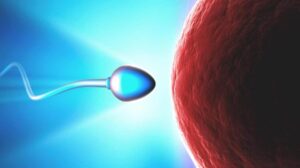How Blocked Sperm Is Related To Male Infertility? | Causes, Diagnosis and Treatment
Do you want to know what is blocked sperm duct is and how it is related to male infertility? Well, we got you. Because this is what this article is all about. In this article, we will take an in-depth look at all aspects of it. Now, if that sounds interesting to you, then let’s begin.
Table of Contents
Blocked Sperm – Male Infertility | Causes, Diagnosis and Treatment
With unprotected intercourse, around 13 out of 100 couples are unable to conceive. Infertility affects both men and women for a variety of reasons.
More than a third of infertility cases have a malefactor. Most of the time, this is due to issues with his sperm production or delivery.
Causes
Many factors go into producing mature, healthy sperm that can travel. A variety of issues may prevent cells from developing into sperm. The sperm may be unable to reach the egg due to a variety of issues. The temperature of the scrotum may have an impact on fertility. The following are the most common reasons for male infertility:
- Disorders of the Sperm
- Retrograde Ejaculation in Varicoceles
- Obstruction of Immunonologic Fertility
- Hormones \sMedication
Sperm Disorders
The most prevalent issues are with sperm production and growth. Sperm may be used to:
- not completely develop, be awkwardly formed, and not travel in the appropriate direction
- be produced in small quantities (oligospermia)
- not be made in any way (azoospermia)
Sperm issues may be caused by inherited characteristics. Sperm counts might be lowered as a result of lifestyle decisions.
Sperm counts may be lowered by smoking, consuming alcohol, and taking certain drugs. Long-term illness (such as renal failure), childhood illnesses (such as mumps), and chromosomal or hormone disorders are also possible reasons for low sperm counts (such as low testosterone).
Low or no sperm might result from damage to the reproductive system. Approximately four out of every ten males with complete sperm deficiency (azoospermia) have a blockage in the tubes through which the sperm migrate. A blockage might be caused by a congenital abnormality or an issue such as an infection.
Obstruction
The tubes that sperm pass through might get obstructed at times. Blockage may be caused by repeated infections, surgery (such as vasectomy), edema, or developmental problems. It is possible to obstruct any section of the male reproductive system. During ejaculation, sperm from the testicles cannot escape the body due to a blockage.
Ejaculatory duct obstruction (EDO)
Causes
Aspermia/azoospermia is a kind of male infertility that develops when both of a man’s ejaculatory ducts are completely blocked. It is conceivable that they may have a tiny amount of semen that lacks the gel-like fluid of the seminal vesicles or no semen at all while having an orgasm, during which they will have involuntary spasms of the pelvic muscle and will be able to pass urine.
This is in contrast to the behavior of a variety of other anejaculation kinds.
Ejaculatory duct blockage may cause a total absence of sperm (aspermia) or extremely low-volume sperm (oligospermia), which may only include the secretion of auxiliary prostate glands positioned downstream of the ejaculatory ducts’ mouth. A total absence of semen (aspermia) or extremely low-volume semen may also arise from ejaculatory duct occlusion (oligospermia)
Diagnosis
Low-volume, runny/fluid sperm (oligospermia) or no sperm at all (dry ejaculation/aspermia) originate from occlusion of the seminal vesicles, which are responsible for the bulk of the volume of the semen. During masturbation, most men will be able to see a runny/fluid, low-volume sperm on their own.
A chemical analysis of the semen of affected men will indicate a low fructose content and a low pH since the seminal vesicles contain a viscous, alkaline fluid rich in fructose. Microscopic analysis of the sperm will reveal Aspermia/azoospermia.

Because the outflow of the seminal vesicles is not impeded if both vasa deferentia are blocked, a semen analysis will reveal aspermia/azoospermia as well as an almost average volume of semen (which may be the outcome of deliberate sterilization).
Assume that the azoospermia is caused by a blockage of the vasa deferentia. Because fructose is mostly obtained from the fluid stored in the seminal vesicles rather than the circulation, the fructose content in the semen will be predicted in that situation.
EDO Treatment
Ejaculatory duct blockage may be treated with a technique called transurethral resection of the ejaculatory ducts (TURED).
This surgical procedure is highly invasive, has serious side effects, and has resulted in spontaneous pregnancies in the partners of approximately 20% of males who have undergone this procedure.
One disadvantage of the surgery is the removal of the valves at the openings of the ejaculatory ducts into the urethra, which causes urine to flow backward into the seminal vesicles.
Recanalization of the ejaculatory ducts using a balloon catheter placed transrectally or transurethrally is another experimental technique.
Despite the fact that it is significantly less invasive and retains the anatomy of the ejaculatory ducts, this therapy comes with hazards and uncertain success rates.
Clinical research in Japan is presently looking at the success rate of recanalization of the ejaculatory ducts using balloon dilation.
Most affected men have an average spermatozoa production in their testicles, which means that after spermatozoa were harvested directly from the testicles, for example, by TESE, or from the seminal vesicles (by needle aspiration), they and their partners could be candidates for assisted reproductive treatment options like IVF.
It’s worth noting that in this case, the female spouse receives the majority of the treatment (such as ovarian stimulation and transvaginal oocyte extraction).
